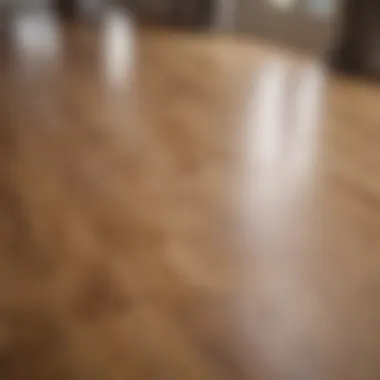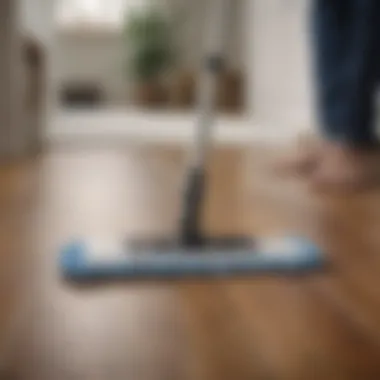Sanitizing Laminate Floors: Essential Cleaning Tips


Intro
Sanitizing laminate floors is an important aspect of maintaining not only the appearance but also the hygiene of your living space. As laminate floors become increasingly popular in residential and commercial properties, understanding effective sanitation methods is crucial. This guide offers a thorough exploration of the best practices for keeping these surfaces clean, ensuring they remain durable and visually appealing over time.
With many households housing pets and children, cleanliness is paramount. This article delves into various cleaning techniques, evaluates suitable products, and provides vital maintenance tips. A focus on safety ensures that the methods recommended are not harmful to family members or the environment. While laminate floors are generally resilient, they do require special attention to avoid damage during cleaning.
Readers will benefit from a structured approach that balances practical recommendations tailored to both homeowners and professionals. Understanding how to sanitize laminate floors will enhance the longevity of your flooring investment while upholding a hygienic environment. This guide is not just a list of cleaning procedures; it is a comprehensive resource that encourages informed decisions.
Understanding Laminate Flooring
Understanding laminate flooring is essential for anyone looking to maintain hygiene and enhance longevity in their interior spaces. This section delves into the unique aspects, benefits, and common maintenance challenges associated with laminate floors. By grasping the fundamental properties of laminate flooring, homeowners and professionals can make informed decisions on cleaning and sanitization practices.
Composition of Laminate Floors
Laminate flooring is composed of multiple layers designed to provide durability, aesthetic appeal, and ease of maintenance. The typical structure includes:
- Wear Layer: The top layer that protects against scratches and fading. This layer is crucial for long-term durability.
- Design Layer: Beneath the wear layer, this printed layer gives the laminate its appearance, mimicking natural materials like wood or stone.
- Core Layer: This layer adds strength and stability, often made of high-density fiberboard (HDF), which helps resist moisture.
- Backing Layer: The bottom layer provides additional stability and waterproof properties, acting as a barrier against water damage.
Such a combination ensures that laminate floors offer a robust option for various environments, though understanding these layers enhances the effectiveness of sanitization efforts.
Benefits of Laminate Flooring
Laminate flooring presents a range of advantages that appeal to many homeowners. The key benefits include:
- Affordability: Generally more cost-effective than hardwood or stone flooring, laminate provides a budget-friendly solution without compromising on style.
- Easy Installation: Many laminate products are designed for DIY installation, often featuring a click-lock system, which simplifies the process.
- Variety of Styles: With a wide array of designs, colors, and finishes available, laminate can fit any decor, from traditional to modern.
- Low Maintenance: Regular cleaning and periodic maintenance suffice to keep laminate floors in good condition. They resist staining and can typically be cleaned with simple everyday cleaning products.
- Environmentally Friendly Options: Certain brands offer laminate flooring made from sustainable materials, which align with eco-conscious preferences.
These benefits contribute to the growing popularity of laminate flooring, yet they also necessitate effective sanitization to maintain their appeal and integrity over time.
Common Challenges in Maintenance
Maintenance of laminate flooring, while generally straightforward, does present challenges that should be acknowledged. Some common issues include:
- Moisture Sensitivity: Although many laminate floors have moisture resistance, excessive water can still warp the boards if not addressed promptly.
- Scratches and Dents: Heavy furniture or sharp objects can leave marks on laminate surfaces, which may mar the aesthetic appeal.
- Cleaning Residue: Using improper cleaning products can leave a residue that dulls the finish, necessitating more frequent cleaning.
- Dirt Accumulation: Without regular maintenance, dirt can build up in seams, diminishing the floor's cleanliness and appearance.
Addressing these challenges effectively requires an understanding of the material's properties and adopting appropriate cleaning practices that promote both hygiene and durability.
Proper maintenance is not just about aesthetics; it also ensures the safety and longevity of your investment.
By comprehending the nature of laminate flooring, readers can better appreciate the importance of sanitization methods, leading to a healthier living environment.
The Importance of Sanitization
In the context of laminate flooring, proper sanitization is not merely an aesthetic concern; it is a fundamental aspect impacting health and longevity. The accumulation of dirt, bacteria, and allergens can create an environment that is unfavorable for inhabitants. Regular sanitization helps eliminate these concerns, serving not just the immediate hygiene but also thoughtful preventative maintenance of the flooring itself.
Health Implications of Poor Hygiene
Neglecting to sanitize laminate floors can lead to significant health issues. Laminate surfaces, while durable, can harbor pathogens if not properly cleaned. Dust mites and other allergens thrive in untreated spaces, potentially exacerbating respiratory issues such as asthma or allergies. Moreover, a dirty floor can become a breeding ground for bacteria and viruses, placing inhabitants at risk of infections, which is particularly concerning in homes with children or elderly individuals.
A study highlighted in various health resources suggests that households with poor sanitization practices are more likely to experience higher rates of illness. Taking steps to regularly disinfect and clean floors is an important public health practice.


Preventing Dirt and Germ Accumulation
To prevent the accumulation of dirt and germs, a structured cleaning routine is essential. It starts with daily practices like sweeping or vacuuming, which should be a habit to ensure that loose particles do not settle into deeper seams of the flooring. In addition, utilizing mats at entries can significantly reduce the amount of dirt brought into the home.
Next, a weekly cleaning schedule should be implemented where surfaces are mopped with suitable cleaning solutions. Deep sanitization, ideally once a month, would include the use of products recommended for laminate floors that can effectively kill germs without damaging the surface. Having these measures in place promotes not only a clean environment but also extends the lifespan of the flooring.
By instituting these practices, individuals can foster a healthier living space while effectively maintaining their laminate floors. Care and regular attention to sanitization contribute to the overall maintenance, ensuring sustained quality and usage of laminate flooring.
Preparation for Cleaning
Preparing for the cleaning of laminate floors is essential for achieving optimal results. This phase sets the stage for an effective sanitization process. By taking the time to ensure everything is in place, one can avoid common mistakes and enhance the effectiveness of chosen cleaning methods. Preparation not only makes the cleaning process smoother but also reduces the risk of damaging the flooring. Proper preparation ultimately saves time and effort, leading to a more enjoyable cleaning experience.
Gathering Necessary Supplies
Before starting the cleaning, it's crucial to gather all necessary supplies. Having everything at hand prevents interruptions during the process. The basic items you will need include:
- A soft-bristle broom or vacuum cleaner
- Microfiber mop or cloth
- Cleaning solution specifically designed for laminate floors
- Bucket or spray bottle for dilution
- Optional: essential oils for added freshness
Choosing the right cleaning products is critical. Products such as Bona Laminate Cleaner or Zep Hardwood and Laminate Floor Cleaner are effective options. If opting for homemade solutions, a simple mix of vinegar and water can work, but it should be used cautiously.
Clearing the Area
Once the supplies are ready, the next step is to clear the area of furniture and any obstructions. This task often involves moving smaller items like chairs, rugs, and tables. This ensures that all surfaces are accessible during cleaning and allows for an even distribution of cleaning solutions.
In addition, clearing the area helps prevent accidental damage to furniture by avoiding contact with wet floors. Make sure to sweep or vacuum before applying any cleaning solutions to remove dirt and debris. Paying attention to edges and corners where dust tends to accumulate is important. By preparing the area properly, you pave the way for thorough sanitization.
"Cleaning is not merely an act of tidying up; it is a ritual that enhances the space you inhabit."
Effective Cleaning Techniques
In maintaining the integrity and hygiene of laminate floors, effective cleaning techniques play a vital role. Regular and proper cleaning not only preserves the aesthetic appearance of the flooring but also extends its lifespan. Effective cleaning techniques ensure that dirt, grime, and bacteria do not accumulate, allowing homeowners to enjoy a healthy living environment. It is essential to balance convenience with efficacy in order to optimize cleaning efforts without damaging the laminate surface.
Daily Maintenance Practices
Daily maintenance is crucial for ensuring that laminate floors remain pristine. Sweeping or vacuuming the surface each day helps remove loose dirt and debris, preventing scratching and further buildup. It is recommended to use a soft-bristle broom or a vacuum designed for hard surfaces to avoid causing any damage. Additionally, using a microfiber mop can effectively capture dust and allergens, contributing to better indoor air quality.
Spot Cleaning Spills and Stains
When spills occur, immediate attention is necessary to prevent potential staining. It is best to blot rather than wipe, using a clean cloth for optimal effect. Water can be used for most spills, but a mild soap solution might be needed for stubborn stains, such as food or drink. Always avoid abrasive cleaners, as they can dull the surface of the laminate. By addressing spills quickly and efficiently, homeowners can maintain a clean and hygienic floor without significant effort.
Deep Cleaning Methods
Deep cleaning methods should be implemented periodically to thoroughly sanitize laminate floors. Here are three effective approaches:
Using Steam Mops
Steam mops are a popular choice for deep cleaning laminate floors because they harness the power of steam to eradicate germs and grime. The key characteristic of steam cleaning is that it sanitizes without the need for harsh chemicals, which is beneficial for both the environment and the health of your home. Steam mops can easily penetrate cracks and crevices, bringing out dirt where traditional mopping might fail. However, homeowners should ensure that their laminate can tolerate moisture since excessive water exposure can damage the planks.
Recommended Solutions


Commercially available cleaning solutions are designed specifically for laminate floors and can be advantageous in achieving high hygiene standards. These solutions typically contain cleaning agents that effectively lift dirt without causing damage. It is essential to follow manufacturer instructions to maximize benefits and prevent any adverse reactions on the flooring. Regular use of these solutions can significantly enhance the floor's appearance and hygiene, but caution should be exercised regarding the types of cleaners used, as not all products are suitable for laminate.
Manual Scrubbing Techniques
Manual scrubbing can be an effective method for tackling tough stains or heavily soiled areas. Using a soft cloth or sponge combined with a mild detergent allows for targeted cleaning with less risk of irritation to the floor's surface. This approach enables homeowners to clean specific spots without over-saturation, which is crucial for maintaining the flooring’s integrity. However, keeping in mind the potential for physical effort involved, it's important to combine this technique with more automated cleaning methods for overall maintenance efficiency.
Recommended Cleaning Products
Choosing the right cleaning products is crucial for maintaining laminate floors. The products you select should effectively cleanse while also ensuring the longevity of the flooring material. Using inappropriate products may lead to dullness, scratches, or even damage to the laminate surface. Understanding the spectrum of available cleaning solutions helps in making informed choices.
Commercial Cleaning Solutions
Commercial cleaning solutions are specifically formulated to target dirt and stains on laminate floors. These products often come ready to use, requiring minimal preparation. They typically contain specialized agents that effectively tackle tough grime. Look for products labeled as safe for laminate surfaces.
Some advantages of commercial cleaners include:
- Ease of Use: Most require no mixing or dilution.
- Time Efficiency: Designed for quick application and fast results.
- Effectiveness: Formulated to fight tough stains without damaging the flooring.
However, it is vital to read user guides and ensure compatibility with your laminate type. Overuse or improper application may still cause issues.
Homemade Cleaning Recipes
Homemade cleaning solutions can be both economical and effective for maintaining laminate floors. They often use common household ingredients, providing a more natural alternative to commercial products. Here are two prominent homemade recipes.
Vinegar and Water Mixture
The vinegar and water mixture is a favored choice among many for cleaning laminate floors. The acetic acid in vinegar acts as a natural disinfectant, effectively cutting through grease and grime. The proportions commonly recommended are one cup of vinegar to one gallon of warm water.
- Key characteristic: Natural disinfectant.
- Benefits: Non-toxic and cost-effective.
- Unique feature: The mixture helps leave floors streak-free when used properly.
However, excessive use of vinegar can lead to dulling of the floor's finish over time, so it is important to use it sparingly.
Essential Oils for Freshness
Incorporating essential oils adds pleasant scents to the cleaning routine. Oils such as tea tree or lavender not only contribute to a fresh aroma but also possess antimicrobial properties. A few drops in your cleaning solution can transform the experience.
- Key characteristic: Aromatic and antimicrobial.
- Benefits: Natural freshness without synthetic chemicals.
- Unique feature: Creates a soothing cleaning experience, making chores less tedious.
It is necessary to not go overboard, as too many essential oils can make the surface greasy, defeating the cleaning purpose. Proper dosage ensures effectiveness without residue.
"Selecting the right cleaning products plays a fundamental role in preserving the beauty and integrity of laminate floors."
Incorporating both commercial solutions and homemade recipes into your cleaning regime provides flexibility. This way, you can tailor the cleaning process to your specific needs while keeping your laminate floors in optimal condition.
Safety Measures During Cleaning
When it comes to sanitizing laminate floors, implementing proper safety measures cannot be overlooked. These practices not only ensure the effectiveness of cleaning efforts but also protect the health of individuals who use the space. Adequate safety precautions help to minimize the risk of accidents, exposure to harmful substances, and damage to the flooring itself.
During the process of cleaning, one should pay attention to specific elements. For instance, proper ventilation while using cleaning products, especially those with strong chemicals, drastically reduces potential fumes and irritants in the air. Understanding and implementing these measures can enhance the sanitization process.


Proper Ventilation
Creating a well-ventilated environment is a crucial step during the cleaning process. Laminate floor cleaning products can emit fumes that might cause respiratory discomfort. Therefore, having windows open or using fans ensures that air circulates and that any undesirable vapors dissipate quickly. This is especially important in smaller rooms where air might become stagnant.
In addition to preventing irritation, proper ventilation can also promote faster drying times for your laminate floors. When floors dry quickly, the risk of moisture seeping into seams and causing damage decreases significantly. Here are some tips for effective ventilation:
- Open windows to let in fresh air.
- Use fans or air purifiers to enhance circulation.
- Avoid cleaning during high humidity days when air exchange might not be effective.
Ensuring proper ventilation while cleaning not only safeguards health but also preserves the quality of your floors.
Choosing Non-toxic Products
In the current landscape, many individuals are becoming increasingly aware of the importance of choosing non-toxic cleaning products. It is essential to select cleaners that do not contain harsh chemicals, which could pose health risks to humans and pets. Non-toxic products serve the dual purpose of maintaining a clean floor while safeguarding the environment.
When searching for suitable cleaning products, look for labels that highlight the eco-friendliness or natural ingredients. These products perform well without compromising safety. Furthermore, using homemade solutions such as a mixture of water and vinegar can be effective and safe. Here’s why non-toxic products are beneficial:
- Reduced health risks: Non-toxic options minimize allergic reactions and respiratory problems.
- Environmentally friendly: They contribute to reduced pollution and waste.
- Prevent long-term damage: Using gentle products keeps floor finishes intact over time.
In summary, prioritizing safety during the cleaning process is vital for successful sanitation of laminate floors. Effective ventilation and choosing non-toxic products collectively enhance the overall cleaning experience, ensuring a hygienic and safe environment for families.
Post-Cleaning Care
Post-cleaning care is a crucial aspect of maintaining laminate floors. After the initial cleaning process, proper care ensures that the flooring remains in top condition. This stage is about enhancing the results of the cleaning and prolonging the life of the laminate. Post-cleaning care not only improves appearance but also helps in preventing long-term damage.
Allowing Floors to Dry
The drying process is an important step. After cleaning, floors can retain moisture. It is vital to allow laminate floors to dry thoroughly before walking on them or placing any furniture back in place. If floors do not dry properly, moisture can seep into seams, causing issues like warping or mold growth.
To aid the drying process, consider the following tips:
- Open windows: This increases air circulation, helping moisture evaporate.
- Use fans: Fans can expedite the drying time, especially in areas with limited airflow.
- Avoid covering: Do not place rugs or other items on the wet surface until it is completely dry.
Routine Maintenance Schedule
Having a routine maintenance schedule is beneficial. It helps to avoid excessive dirt and stains accumulation. Regular upkeep can significantly extend the life of laminate floors. An effective schedule might include:
- Daily cleaning: Wiping down high-traffic areas with a dry mop helps remove dust and dirt.
- Weekly maintenance: Use a damp mop with appropriate cleaning solution to keep floors clean and shiny.
- Monthly inspection: Look for any signs of wear or damage. Addressing these issues promptly can prevent larger problems later.
Routine maintenance not only keeps floors looking their best but also enhances their durability.
"A proactive approach to maintenance can save time and money in the long run."
By implementing these post-cleaning care measures, you can ensure your laminate floors remain appealing and functional for years to come.
The End
The conclusion of this article encapsulates the critical insights on sanitizing laminate floors. A well-maintained laminate floor not only enhances the aesthetic of your home but also contributes to a cleaner living environment. Given the various cleaning methods and products discussed, homeowners can make informed choices that suit their specific needs. By applying the principles elaborated upon in this guide, you can ensure that your laminate flooring remains hygienic and visually appealing.
Summary of Best Practices
To maximize the effectiveness of your cleaning routine, adhere to these best practices:
- Regular Cleaning: Make it a habit to sweep or vacuum your laminate floors daily. This action restricts the collection of dirt and reduces the risk of scratches arising from debris.
- Use Suitable Products: Opt for cleaning solutions specifically designed for laminate flooring. Homemade solutions containing vinegar can work, yet ensure dilution to prevent potential damage.
- Avoid Excess Water: When mopping, use a damp mop instead of soaking it. Excess moisture can seep into seams, causing potential warping or separation.
- Implement Deep Cleaning: Dedicate time every few months for deep cleaning, utilizing steam mops or suitable solutions to eliminate bacteria and grime more effectively.
- Establish a Maintenance Schedule: Create a routine that outlines specific tasks like deep cleaning and inspections. Consistency is key in preserving the quality of your floors.
Implementing these strategies will not only simplify the cleaning process but also prolong the life of your laminate floors. Regular sanitization helps prevent the accumulation of allergens and microbes, ensuring a safer environment for all inhabitants. By committing to these guidelines, you cultivate a home that reflects care and attention to detail.















